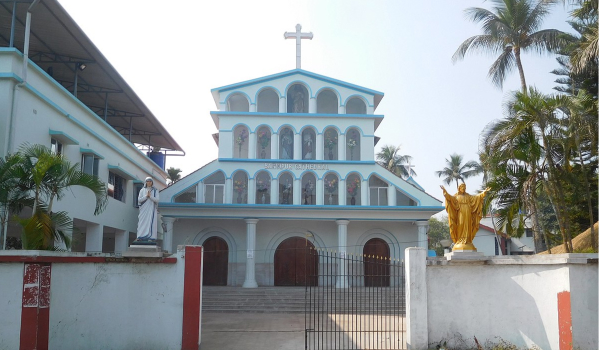
The total population numbers around 8,890,000 and 85 percent of them live in villages. The small urban part of the diocese, only 10 percent of its area, is concentrated in a narrow belt that borders the Hooghly River. Most of the people are lower caste Dalits and tribal people account for about 2.2 percent of the population.
Bengali is the common language.
The first missionary to land in the region of the present diocese was a Spanish Carmelite Father in 1840 at Koikhali, now in the parish of Raghabpur. At the time, the area was under the apostolic vicariate of Bengal with its headquarters in Calcutta. But Koikhali had no priest from 1847. The Belgian Jesuits came to the region in 1859, and Jesuit Father Goffinet, remembered for living a saintly life, went to Koikhali in 1868. Pioneering Jesuit missionary Father E. Delplace established five mission stations from 1873 to 1877. In 1886, the vicariate was elevated to become Calcutta archdiocese. Local missionary work received a boost when the Yugoslav Jesuit priests took charge of 24 Parganas, then a single district, in 1925. After World War II and Indian independence, local priests took over the missions. Baruipur became a separate diocese with Jesuit Bishop Linus Nirmal Gomes as its first bishop, on Nov. 19, 1977. Bishop Gomes resigned due to ill health on Oct. 31, 1995, and Bishop Lobo succeeded him on Jan. 29, 1998. Bishop Salvadore Lobo retired on May 4, 2020 and Bishop Shyamal Bose took the office on May 4, 2020.
The diocese covers 10,568 square kilometers. It is located in the southern part of West Bengal state, comprising the whole of South 24 Parganas district with its 3, 470 villages, six municipal towns and 32 non-municipal towns, as well as some parts of Calcutta and North 24 Parganas district. Two parishes are in Calcutta. Shaped like an irregular rectangle about 120 kilometers north-to-south and 90 kilometers east-to-west, the diocese serves the Indian part of the Ganges delta. State Highways 1 and 3 run through this district, as does the Eastern Railway line. Ferry services are also an important mode of transportation in this district.
People depend mainly on agriculture. Rice is the main and often the only crop, although 35 percent of the population own no land and only 4 percent own more than three acres. Due to salinity of the soil, and poor drainage and irrigation facilities, yields are low and usually only once a year. It is said that ponds outnumber houses in every village, and many villagers grow fish. They also cultivate vegetables and fruit.
No major industries have been established in the diocese. People go to Calcutta to work. Thousands of commuters earn their livelihood there as fruit and vegetable vendors, office or factory workers, traders, etc. Calcutta offers advanced medical care and education opportunities.
Baruipur is a small town of about 50,000 people situated 25 kilometers south of Calcutta, accessible by rail and road. Calcutta dominates many aspects of local life. Baruipur and Diamond Harbour, near where the Hooghly meets the Bay of Bengal, are the main towns. Bakkhali, 130 kilometers from Calcutta, is the second most important beach in the state.
The area is endowed with great natural beauty, which attracts tourists. Important tourist spots are: Falta, Nurpur, Raychak, Diamond Harbour and Bakkhali. However, an inadequate communication infrastructure has limited the potential for tourism.
Ganga Sagar or Sagardwip, where the Ganges meets the Bay of Bengal, is considered one of the holiest sites for Hindus. The annual three-day Ganga Sagar mela (festival), held in mid-January, attracts millions of devotees. Sajnekhali bird sanctuary has exotic species of birds. Sundarbans is a part of the world's largest delta, consisting of the mouths of the Ganges, Brahmaputra and Meghna rivers. Sundarban national park has an area of 1,330 square kilometers and has been recognized as a world heritage site by UNESCO. It is home to the Royal Bengal Tiger.
70 percent literacy rate.